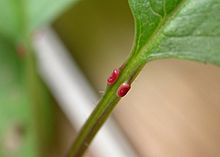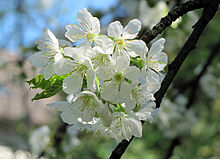- Prunus avium
-
This article is about the tree. For other uses, see Wild Cherry (disambiguation).
Prunus avium 
Wild cherry foliage and fruit Scientific classification Kingdom: Plantae (unranked): Angiosperms (unranked): Eudicots (unranked): Rosids Order: Rosales Family: Rosaceae Genus: Prunus Subgenus: Cerasus Species: P. avium Binomial name Prunus avium
(L.) L. 1755Prunus avium, commonly called wild cherry,[1] sweet cherry,[1] bird cherry,[1] or gean,[1] is a species of cherry, native to Europe, west Turkey, northwest Africa, and western Asia, from the British Isles[2] south to Morocco and Tunisia, north to the Trondheimsfjord region in Norway and east to the Caucasus, and northern Iran, with a small disjunct population in the western Himalaya.[3][4] This species has a diploid set of sixteen chromosomes (2n=16).[5] All parts of the plant except for the ripe fruit are slightly toxic, containing cyanogenic glycosides.
Contents
Description and ecology
It is a deciduous tree growing to 15–32 m tall, with a trunk up to 1.5 m diameter. Young trees show strong apical dominance with a straight trunk and symmetrical conical crown, becoming rounded to irregular on old trees. The bark is smooth purplish-brown with prominent horizontal grey-brown lenticels on young trees, becoming thick dark blackish-brown and fissured on old trees. The leaves are alternate, simple ovoid-acute, 7–14 cm long and 4–7 cm broad, glabrous matt or sub-shiny green above, variably finely downy beneath, with a serrated margin and an acuminate tip, with a green or reddish petiole 2–3.5 cm long bearing two to five small red glands. The tip of each serrated edge of the leaves also bear small red glands.[6] In autumn, the leaves turn orange, pink or red before falling. The flowers are produced in early spring at the same time as the new leaves, borne in corymbs of two to six together, each flower pendent on a 2–5 cm peduncle, 2.5–3.5 cm diameter, with five pure white petals, yellowish stamens, and a superior ovary; they are hermaphroditic, and pollinated by bees. The fruit is a drupe 1–2 cm in diameter (larger in some cultivated selections), bright red to dark purple when mature in mid summer, edible, variably sweet to somewhat astringent and bitter to eat fresh; it contains a single hard-shelled stone 8–12 mm long, 7–10 mm wide and 6–8 mm thick, grooved along the flattest edge; the seed (kernel) inside the stone is 6–8 mm long.
The fruit are readily eaten by numerous birds and mammals, which digest the fruit flesh and disperse the seeds in their droppings. Some rodents, and a few birds (notably the Hawfinch), also crack open the stones to eat the kernel inside. All parts of the plant except for the ripe fruit are slightly toxic, containing cyanogenic glycosides.[7][8][9]
The leaves provide food for some animals, including Lepidoptera such as the case-bearer moth Coleophora anatipennella.
The tree exudes a gum from wounds in the bark, by which it seals the wounds to exclude insects and fungal infections.[10]
Nomenclature
The early history of its classification is somewhat confused. In the first edition of Species Plantarum (1753), Linnaeus treated it as only a variety, Prunus cerasus var. avium, citing Gaspard Bauhin's Pinax theatri botanici (1596) as a synonym;[clarification needed] his description, Cerasus racemosa hortensis ("Cherry with racemes, of gardens")[clarification needed] shows it was described from a cultivated plant.[11] Linnaeus then changed from a variety to a species Prunus avium in the second edition of his Flora Suecica in 1755.[12]
Prunus avium means "bird cherry" in the Latin language.[4] In English, the name Bird cherry refers to Prunus padus.[13]
Wild cherry has been known as Gean or Mazzard (also 'massard'), both largely obsolete names in modern English, though more recently 'Mazzard' has been used to refer to a selected self-fertile cultivar that comes true from seed, and which is used as a seedling rootstock for fruiting cultivars.[14][15] The name "wild cherry" has also been applied in a general or colloquial sense to other species of Prunus growing in their native habitats, particularly to Black Cherry Prunus serotina.
Some eighteenth and nineteenth century botanical authors[who?] ascribed an origin to western Asia based on the writings of Pliny; however, archaeological finds of seeds from prehistoric Europe contradict this view (see below).
Cultivation and uses
Fruit
Wild cherries have been an item of human food for several thousands of years. The stones have been found in deposits at Bronze Age settlements throughout Europe, including in Britain.[14] In one dated example, Wild cherry macrofossils were found in a core sample from the detritus beneath a dwelling at an Early and Middle Bronze Age pile-dwelling site on and in the shore of a former lake at Desenzano del Garda or Lonato, near the southern shore of Lake Garda, Italy. The date is estimated at Early Bronze Age IA, carbon dated there to 2077 BC plus or minus 10 years. The natural forest was largely cleared at that time.[16]
By 800 BC, cherries were being actively cultivated in Asia Minor, and soon after in Greece.[14]
As the main ancestor of the cultivated sweet cherry, the Wild cherry is one of the two cherry species which supply most of the world's commercial cultivars of edible cherry (the other is the Sour cherry Prunus cerasus, mainly used for cooking; a few other species have had a very small input).[14] Various cherry cultivars are now grown worldwide wherever the climate is suitable; the number of cultivars is now very large.[14] The species has also escaped from cultivation and become naturalised in some temperate regions, including southwestern Canada, Japan, New Zealand, and the northeast and northwest of the United States.[4]
Ornamental
It is often cultivated as a flowering tree. Because of the size of the tree, it is often used in parkland, and less often as a street or garden tree. The double-flowered form, 'Plena', is commonly found, rather than the wild single-flowered forms.[17]
Two interspecific hybrids, P. x schmittii (P. avium x P. canescens) and P. x fontenesiana (P. avium x P. mahaleb) are also grown as ornamental trees.[17]
Timber
The hard, reddish-brown wood (cherry wood) is valued as a hardwood for woodturning, and making cabinets and musical instruments.[10]
Other uses
The gum from bark wounds is aromatic and can be chewed as a substitute for chewing gum.
Medicine can be prepared from the stalks of the drupes that is astringent, antitussive, and diuretic.[15]
A green dye can also be prepared from the plant.[15]
Cultural history
Pliny distinguishes between Prunus, the plum fruit,[18] and Cerasus, the cherry fruit.[19] Already in Pliny quite a number of cultivars are cited, some possibly species or varieties, Aproniana, Lutatia, Caeciliana, and so on. Pliny grades them by flavour, including dulcis ("sweet") and acer ("sharp").[20]
He goes so far as to say that before the Roman consul Lucius Licinius Lucullus defeated Mithridates in 74 BC, Cerasia ... non fuere in Italia, "There were no cherry trees in Italy". According to him, Lucullus brought them in from Pontus and in the 120 years since that time they had spread across Europe to Britain.[19]
Seeds of a number of cherry species have however been found in Bronze Age and Roman archaeological sites throughout Europe. The reference to "sweet" and "sour" supports the modern view that "sweet" was Prunus avium; there are no other candidates among the cherries found. In 1882 Alphonse de Candolle pointed out that seeds of Prunus avium were found in the Terramare culture of north Italy (1500-1100 BC) and over the layers of the Swiss pile dwellings.[21] Of Pliny's statement he says (p. 210):
Since this error is perpetuated by its incessant repetition in classical schools, it must once more be said that cherry trees (at least the bird cherry) existed in Italy before Lucullus, and that the famous gourmet did not need to go far to seek the species with the sour or bitter fruit.
De Candolle suggests that what Lucullus brought back was a particular cultivar of Prunus avium from the Caucasus. The origin of cultivars of P. avium is still an open question. Modern cultivated cherries differ from wild ones in having larger fruit, 2–3 cm diameter. The trees are often grown on dwarfing rootstocks to keep them smaller for easier harvesting.[22]
References
- ^ a b c d "USDA GRIN taxonomy". http://www.ars-grin.gov/cgi-bin/npgs/html/taxon.pl?29844.
- ^ British Trees Online
- ^ Euro+Med Plantbase Project: Prunus avium
- ^ a b c Den Virtuella Floran: Prunus avium (in Swedish; with map)
- ^ Tavaud, M.; Zanetto, A.; David, J.L.; Laigret, F.; Dirlewanger, E. (2004). Genetic relationships between diploid and allotetraploid cherry species (Prunus avium, Prunus xgondouinii and Prunus cerasus). Heredity. 93(6): 631–638.
- ^ Jim Conrad's Newsletter. Cherry leaf glands.
- ^ Rushforth, K. (1999). Trees of Britain and Europe. Collins ISBN 0-00-220013-9.
- ^ Mitchell, A. F. (1974). Field Guide to the Trees of Britain and Northern Europe. Collins ISBN 0-00-212035-6.
- ^ Flora of NW Europe: Prunus avium
- ^ a b Vedel, H., & Lange, J. (1960). Trees and Bushes in Wood and Hedgerow. Metheun & Co. Ltd., London.
- ^ Linnaeus, C. (1753). Species Plantarum 1: 474. Online facsimile.
- ^ Linnaeus, C. (1755). Flora Suecica, ed. 2: 165.
- ^ Flora of NW Europe: Prunus padus
- ^ a b c d e Huxley, A., ed. (1992). New RHS Dictionary of Gardening. Macmillan ISBN 0-333-47494-5.
- ^ a b c Plants for a Future: Prunus avium
- ^ Marinis, R. C. de, Rapi, M., Ravazzi, C., Arpenti, E., Deaddis, M., & Perego, R. (2005). Lavagnone (Desenzano del Garda): new excavations and palaeoecology of a Bronze Age pile dwelling site in northern Italy. In: DellaCasa, P. & Trachsel, M., eds. Wetland Economies and Societies. Proceedings of the International Conference in Zurich, 10–13 March 2004. Collectio Archæologica 3: 221–232 Available online (pdf file)
- ^ a b European Garden Flora; Volume IV
- ^ Natural History Book XV Section XII.
- ^ a b Pliny. Natural History Book XV Section XXX.
- ^ N.H. Book XV Sections XXXI-II.
- ^ Candolle, A. de (1882). Origine des plantes cultivées. Geneva.
- ^ Panda, S., Martin, J. P., & Aquinagalde, I. (2003). Chloroplast DNA study in sweet cherry cultivars (Prunus avium L.) using PCR-RFLP method. Genetic Resources and Crop Evolution 50 (5): 489-495. Abstract
Categories:- Cherries
- Prunus
- Flora of Europe
- Flora of the Mediterranean
- Flora of Western Asia
- Flora of the Himalayas
- Flora of Pakistan
- Flora of Iran
- Flora of Morocco
- Flora of Norway
- Flora of Tunisia
- Symbols of Utah
- Garden plants of Asia
- Garden plants of Europe
- Ornamental trees
- Trees of humid continental climate
- Trees of mild maritime climate
Wikimedia Foundation. 2010.



